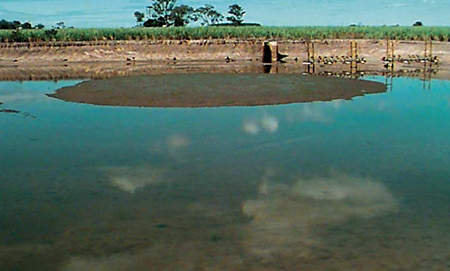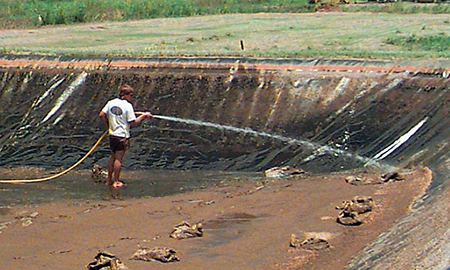Multidisciplinary approach to research is likely to reap the greatest benefits

One of the key challenges facing the shrimp-farming industry is to develop and apply new practices and technologies that improve the efficiency with which the nitrogen in shrimp feeds is converted to shrimp biomass. It is also critical to ensure that residual nitrogen waste is minimized or eliminated prior to discharge into receiving waters. The ability to meet these challenges depends on an understanding of the fate and transformations of nitrogen in shrimp production ponds and effluent treatment systems.
Feeds and feeding

CSIRO Marine Research studies of intensive P. monodon ponds in Australia have shown that 90 percent of the nitrogen enters the ponds as commercial feed, but only 22 percent is retained by the shrimp at harvest. The low retention of nitrogen in shrimp suggests there is considerable room for improvements in both feed ingredients and feed stability.
Fortunately, incremental improvements achieved over the last five years are likely to continue (Table 1). The development of feeds with lower protein levels to reduce nitrogen waste in P. monodon systems may also have potential. This would be enhanced if coupled with selective breeding for optimal performance on low-protein feeds.
Burford, Potential for improvements in nitrogen waste reduction, Table 1
| Parameter | 1995-2000 | 2000-05 |
|---|---|---|
| Feed formulations | ** | ** |
| Feeding practices | * | *** |
| In-pond improvements | * | ** |
| Treatment/recirculation systems | ** | *** |
| Selective breeding | – | ** |
* = some improvement *** = major improvement
Table 1. Potential for improvements in nitrogen waste reduction in P. monodon pond systems.
Selective breeding
The scope for selective breeding to improve nitrogen retention is, as yet unknown. However, based on results from selective breeding of salmon, there is potential to significantly reduce nitrogen waste as selective breeding of P. monodon becomes more widely adopted.
Improved management
The P. monodon-farming industry continues to use feeding trays to determine feeding requirements in ponds. There is, therefore, considerable scope for more technologically advanced feeding mechanisms, such as automated feeders and feedback loops, which will substantially reduce feed waste. However, the benefits to the industry will only be realized if the technological advances are cost-effective.
Pond processes
Most of the nitrogen added to a pond system in commercial feed results in high concentrations of ammonium and dissolved organic nitrogen (DON), and a high biomass of particulate matter, mostly nanoplankton and bacteria.
Reducing ammonium
CSIRO’s researchers found that 70 percent of the ammonium in P. monodon ponds was released from the sediment, particularly in the sludge zone where waste feed and other detritus accumulates. Therefore, we estimate that continual removal of sludge during the grow-out season would result in a 60 percent reduction in ammonium fluxes from the sediment, and have a significant effect on ammonium concentrations in the water.
Improving ponds
However, improving sediment quality requires an integrated approach to pond design and management. Firstly, the production of a sludge pile could be substantially reduced by fully or partially lining the pond walls. This is because most of the sludge accumulated in the pond center is the result of scouring of the pond walls. The reduction of scouring has the added benefit of reducing turbidity, which improves light availability for phytoplankton, and hence their effectiveness at assimilating ammonium.
Unless phytoplankton are removed from the pond system, however, the biomass ultimately becomes detritus that accumulates in the sludge zone and is remineralized to produce ammonium. Increased circulation in lined ponds is needed to reduce sludge deposition and hence remineralization processes.
Stimulating denitrification
Ammonium can also be converted to nitrate, via nitrification, and ultimately to a gaseous form (N2) via denitrification. Our experiments showed that only 0.4 to 2 percent of the nitrogen added to ponds late in the grow-out season was removed by denitrification in the sediment.
It may be possible to stimulate these processes in shrimp ponds in a number of ways. The use of physical substrates, possibly reducing flushing rates from ponds to prevent slow-growing nitrifiers from being diluted, and altering the redox potential in the sediment may promote denitrification. All these strategies are obviously linked to modifications in pond design and management.
Treatment and recirculation
The studies found that a high proportion of the nitrogen added to the ponds (57 percent over a shrimp growth season) was discharged from ponds. The use of settlement ponds has the potential to reduce these nitrogen levels, although the systems we studied at commercial farms only reduced particulate nitrogen loads in discharge waters up to 20 percent. The remainder was principally DON and ammonium.
Much of the DON in pond systems appears to be produced directly from shrimp feeds and feeding processes, and is not readily utilized by the natural biota. Therefore, improvements to feeds and feeding practices are more likely to significantly reduce DON concentrations in ponds.
There is hope for significant improvements in treatment and recirculation systems that will reduce nitrogen waste discharged from farms. However, these systems are likely to be expensive for farmers unless waste recapture is cost effective. One recapture strategy is the cultivation of a secondary cash crop (fish, crustaceans, seaweeds) in the waste treatment ponds.
Conclusion
There will be increasing pressure on shrimp farmers in the future to significantly reduce nitrogen waste. Developing an understanding of the dominant processes in shrimp pond and treatment systems provides a means of targeting research aimed at reducing such waste. An integrated and multidisciplinary approach to research in this area – involving nutritionists, ecologists, geneticists and engineers – is likely to reap the greatest benefits for farmers, and ultimately ensure the future sustainability of the industry.
(Editor’s Note: This article was originally published in the April 2001 print edition of the Global Aquaculture Advocate.)
Now that you've finished reading the article ...
… we hope you’ll consider supporting our mission to document the evolution of the global aquaculture industry and share our vast network of contributors’ expansive knowledge every week.
By becoming a Global Seafood Alliance member, you’re ensuring that all of the pre-competitive work we do through member benefits, resources and events can continue. Individual membership costs just $50 a year. GSA individual and corporate members receive complimentary access to a series of GOAL virtual events beginning in April. Join now.
Not a GSA member? Join us.
Authors
-
Michele A. Burford
CSIRO Marine Research
Cleveland, Queensland, Australia[117,97,46,111,114,105,115,99,46,101,110,105,114,97,109,64,100,114,111,102,114,117,98,46,101,108,101,104,99,105,109]
-
Christopher J. Jackson
CSIRO Marine Research
Cleveland, Queensland, Australia[117,97,46,111,114,105,115,99,46,101,110,105,114,97,109,64,110,111,115,107,99,97,106,46,115,105,114,104,99]
-
Nigel P. Preston
CSIRO Marine Research
Cleveland, Queensland, Australia[117,97,46,111,114,105,115,99,46,101,110,105,114,97,109,64,110,111,116,115,101,114,112,46,108,101,103,105,110]
Related Posts

Aquafeeds
Advantages of aerated microbial reuse systems with balanced C:N, part 1
An alternative waste treatment is intense microbial processing of wastes to facilitate high yields with little or no water exchange.

Responsibility
Decomposition of organic matter in aquaculture systems
In his latest article, Professor Boyd discusses various aspects of the origin and decomposition of organic matter in various aquaculture systems.

Innovation & Investment
Low-space bioreactors remove ammonia in recirculating systems
Despite their relatively small footprint, low-space bioreactors deliver sustainable and cost-effective biological wastewater treatment, particularly in recirculating aquaculture systems, where ammonia removal is critical.

Health & Welfare
Product improves nitrification in RAS
Healthy populations of both ammonia- and nitrite-oxidizing bacteria must be present in aquaculture systems to support the nitrification of potentially toxic ammonia to nitrite, with further oxidation to less problematic nitrate.


